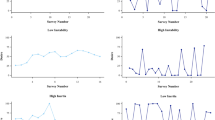Abstract
Generally, no functional role, except pleasure, is assigned to a women's coital orgasm. Recently, however, researchers have suggested that women can regulate the number of sperm accepted or rejected by manipulation coital orgasm timing. Baker and Bellis (1995) demonstrated that women retain more sperm if coital orgasm occurs after, rather than before male ejaculation. The present study investigated (i) factors associated with coital orgasm frequency and (ii) whether women desirous of becoming pregnant report more coital orgasms after than before their partners. Sixty-nine women rated their desire for pregnancy and answered questions about their sexual behaviors, coital orgasm frequency, and coital orgasm timing in relation to their partners. In regression analysis, coital orgasm frequency was predicted by foreplay duration, masturbation frequency, and active sexual participation; desire for pregnancy did not predict coital orgasm frequency. Desire for pregnancywas predicted byage (negatively), active sexual participation (positively), and positively by orgasm after partner ejaculation. Consistent with the Baker and Bellis hypothesis, frequency of orgasm after partner's orgasm remained a significant predictor for desire for pregnancy after controlling for degree of marital happiness, sexual foreplay duration, and coital orgasm frequency.
Similar content being viewed by others
REFERENCES
Baker R. R. (1996). Sperm Wars: In fidelity Sexual Conflicts and Other Bedroom BattlesFourth Estate London.
Baker R. R. and Bellis M. A. (1993). Human sperm competition: Ejaculate manipulation by females and a function for the female orgasm. Anim. Behav.6: 887–909.
Baker R. R. and Bellis M. A. (1995). Human Sperm Competition Copulation Masturbation and InfidelityChapman & Hall London.
Bentler P. M. and Peeler W. H (1979). Models of female orgasm. Arch. Sex. Behav.8: 405–423.
Buss D. M. (1994). The Evolution of Desire. Strategies of Human MatingBasic Books New York.
Buss D. M. and Schmitt D. P. (1993). Sexual strategies theory: An evolutionary perspective on human mating. Psychol. Rev.100: 204–232.
Crooks R. and Bauer K. (1996). Our SexualityBrooks/Cole CA.
Darling C. A. Davidson J. K. Sr. and Cox R. P. (1991). Female sexual response and the timing of partner orgasm. J. Sex Marital Ther.17: 3–21.
Diamond J. (1992). The Third Chimpanzee. The Evolution and Future of the Human AnimalsHarper Perennial New York.
Fisher S. (1973). The Female Orgasm. Psychology Physiology FantasyBasic Books New York.
Fox C. A. Wolff H. S. and Baker J. A. (1970). Measurement of intra-vaginal and intra-uterine pressures during human coitus by ratio-telemetry. J. Reprod. Fertil.22: 243–251.
Hurlbert D. F. (1993). A comparative study using orgasm consistency training in the treatment of women reporting hypoactive sexual desire. J. Sex Marital Ther.19: 41–55.
Hurlbert D. F. Apt C. and Rabehl S. M. (1993). Key variables to understanding female sexual satisfaction: An examination of women in nondistressed marriages. J. Sex Marital Ther.19: 154–165.
Hurlbert D. F. Apt C. and Rombough S. (1996). The female experience of sexual desire as a function of sexual compatibility in an intimate relationship. Can. J. Hum. Sex.5: 7–14.
Hurlbert D. F. White C. L. Powell R. D. and Apt C. (1993). Orgasm consistency training in the treatment of women reporting hypoactive sexual desire: An outcome comparison of women-only groups and couple-only groups. J. Behav. Ther. Exp. Psychiat.24: 3–13.
Hurlbert D. F. and Whittaker K. E. (1991). The role of masturbation in marital and sexual satisfaction. J. Sex Educ. Ther.17: 272–282.
Margulis L. and Segan D. (1991). Mystery Dance: On the Evolution of Human SexualitySummit Books New York.
Masters W. Johnson U. and Kolodny R. (1994). HeterosexualityHarper Collins New York.
Morris D. (1967). The Naked ApeCape London.
Norusis M. J. (1993). Base system user guide version 6 SPSS Inc. Chicago.
Sherfey M. J. ( 1966 ). The evolution and nature of female sexuality in relation to psychoanalytic theory. J. Am. Psychoanal. Assoc.14: 28–128.
Smith R. L. (1984). Human sperm competition. In Smith R. L. (ed.) Sperm Competition and the Evolution of Animal Mating SystemsAcademic Press London pp. 601–660.
Symons D. (1979). The Evolution of Human SexualityOxford University Press New York.
Thornhill R. Gangestad S. W. and Comer R. (1995). Human female orgasm and mate fluctuating asymmetry. Anim. Behav.50: 1601–1615.
Tooby J. and Cosmides L. (1992). Psychological foundations of culture In Barkow J. Cosmides L. and Tooby J. (eds.) The Adapted Mind: Evolutionary Psychology and the Generation of CultureOxford University Press New York pp. 19–136.
Trudel G. Boulos L. and Matte B. (1993). Dyadic adjustment in couples with hypoactive sexual desire. J. Sex Educ. Ther.19: 31–36.
Rights and permissions
About this article
Cite this article
Singh, D., Meyer, W., Zambarano, R.J. et al. Frequency and Timing of Coital Orgasm in Women Desirous of Becoming Pregnant. Arch Sex Behav 27, 15–29 (1998). https://doi.org/10.1023/A:1018653724159
Issue Date:
DOI: https://doi.org/10.1023/A:1018653724159




